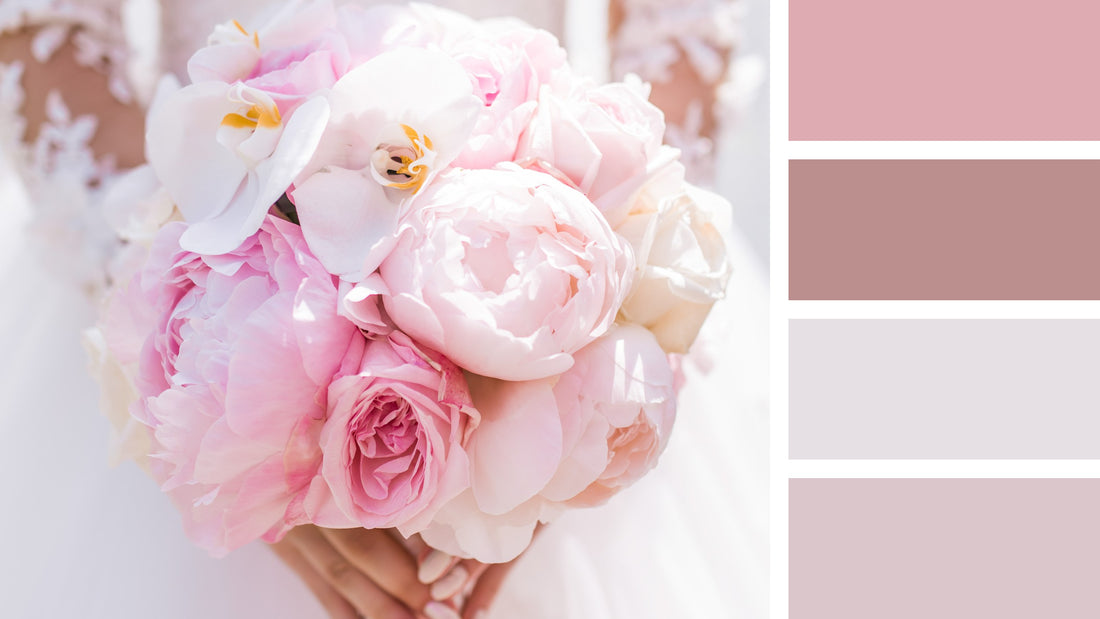When it comes to planning your dream wedding, one of the most fun (and sometimes overwhelming) tasks is choosing your wedding colors! With so many shades to choose from, it can be tough to decide on just a few for your big day. But don't worry, we're here to help! In this post, we'll explore how many wedding colors you can have, and how to make the most of them.
Your wedding color scheme sets the tone for your entire event, from the invitations to the bouquets to the reception decor. It's a chance to let your personality shine, and to make your special day feel like a reflection of you and your partner. Choosing the right colors can be a daunting task, but it doesn't have to be. By considering the season, your venue, and your personal style, you can narrow down your options and create a cohesive and stylish color palette for your wedding. We'll also provide tips on how to use your wedding colors effectively, and share some examples of successful wedding color schemes to inspire you. So if you're feeling overwhelmed by all the color choices for your wedding, read on for some helpful guidance on how to choose the perfect wedding colors for you!

The basics of wedding color schemes:
A wedding color scheme is the combination of colors that you choose for your wedding. Your wedding color scheme sets the tone for your entire event, from the invitations to the bouquets to the reception decor. Choosing the right colors can be a daunting task, but it doesn't have to be.
So, how many wedding colors can you have? There is no hard and fast rule on how many wedding colors you can have, but most wedding color schemes consist of 3-5 main colors. This allows you to create a cohesive look without overwhelming your guests with too many different shades.
When it comes to choosing your wedding colors, there are a few things to consider. First, think about the season of your wedding. Bright and bold colors may be more fitting for a summer wedding, while softer pastels might be more appropriate for a spring or winter wedding. You should also consider the location of your wedding, as the surroundings can influence your color choices. For example, a beach wedding might call for more muted, natural tones, while a formal ballroom might lend itself to a more traditional color palette.
Finally, don't forget to consider your personal style. Your wedding should reflect your personality and tastes, so choose colors that you love and that make you feel happy and confident. You can also use a color wheel to help you pick complementary or analogous colors, which are colors that are next to each other on the wheel and work well together.
There is no right or wrong answer to how many wedding colors you can have, but most wedding color schemes consist of 3-5 main colors. Choose your colors based on the season, location, and your personal style, and use a color wheel to help you select complementary or analogous shades.
Tips for using your wedding colors effectively:
Once you've chosen your wedding colors, it's important to use them effectively to create a cohesive and stylish look for your big day. Here are a few tips for making the most of your wedding colors:
Use your wedding colors consistently: Choose one or two main colors and use them consistently throughout your wedding, from the invitations to the bouquets to the reception decor. This will help to create a cohesive look and make your wedding feel polished and put-together.
Add pops of color: In addition to your main colors, you can also add pops of accent colors to add interest and depth to your wedding color scheme. Accent colors can be used in smaller doses, such as in the ribbon on your bouquets or in the napkins at the reception.
Balance your colors: Make sure to balance your use of colors, so that no one color dominates the wedding. If you have a bold primary color, consider using softer, more muted shades as accents. This will help to create visual interest and balance.
By using your wedding colors consistently, adding pops of color, and balancing your color scheme, you can create a cohesive and stylish look for your big day.
Examples of a few wedding color schemes:
Need some inspiration for your own wedding color scheme? Here are a few examples of successful combinations that might spark some ideas for your own big day:
[Color Scheme 1]: A classic black and white wedding with pops of red. This sophisticated color scheme is timeless and elegant, and the pops of red add a bold and romantic touch. Use black and white as your main colors, and incorporate red in smaller doses, such as in the bouquets or as an accent color on the invitations.

[Color Scheme 2]: A romantic pastel pink and green spring wedding. This soft and feminine color combination is perfect for a spring wedding, and the pastel shades add a touch of whimsy. Use pale pink and mint green as your main colors, and add pops of white and gold for a touch of glamour.

[Color Scheme 3]: A rustic and autumnal wedding with shades of gold, orange, and brown. This warm and cozy color scheme is perfect for a fall wedding, and the rich shades of gold, orange, and brown will create a cozy and inviting atmosphere. Use these colors as your main shades, and incorporate natural elements, such as wood and greenery, to complete the look.

These are just a few examples of successful wedding color schemes, but the possibilities are endless. Don't be afraid to get creative and choose a color combination that reflects your personal style and the mood you want to create for your wedding.
Choosing the right wedding colors can be a challenging task, but it doesn't have to be. By considering the season, location, and your personal style, you can narrow down your options and choose a cohesive and stylish color palette for your big day. Most wedding color schemes consist of 3-5 main colors, and it's important to use them consistently and balance them throughout your wedding. Remember to also add pops of accent color to add interest and depth to your wedding color scheme.
We hope this post has provided you with some helpful guidance on how to choose the perfect wedding colors for your big day. Remember to have fun with the process and choose shades that reflect your personal style and the mood you want to create for your wedding. And don't be afraid to get creative – the possibilities are endless!
Congratulations on your upcoming wedding, and we wish you all the best as you plan your dream celebration! What wedding colors are you considering for your wedding? Or have you already chosen them? Let me know in the comments below!

